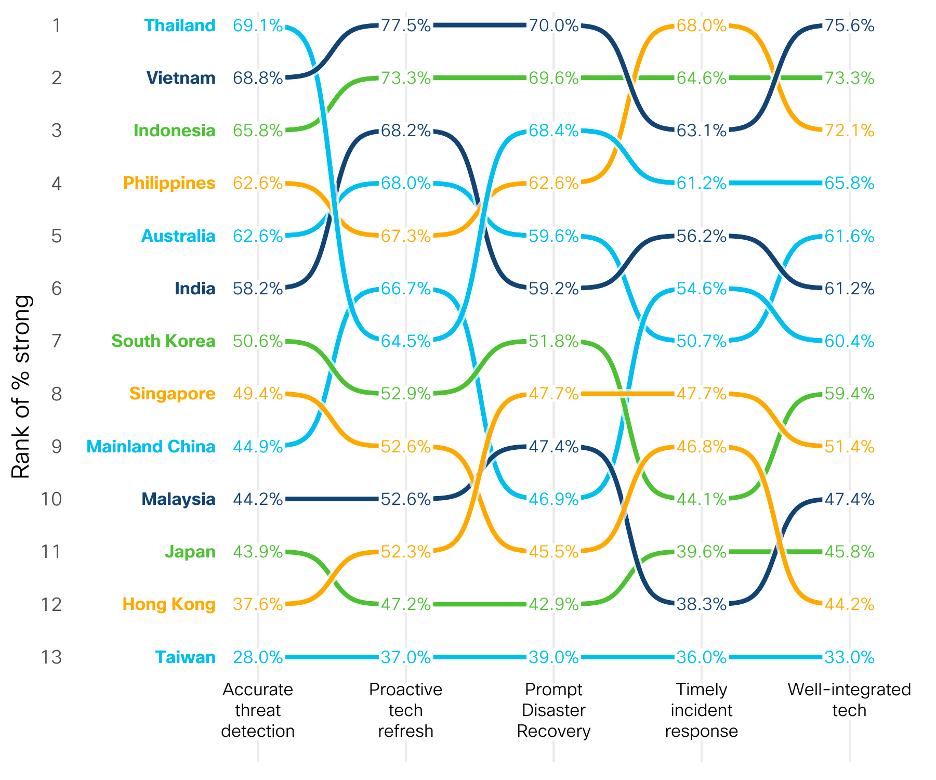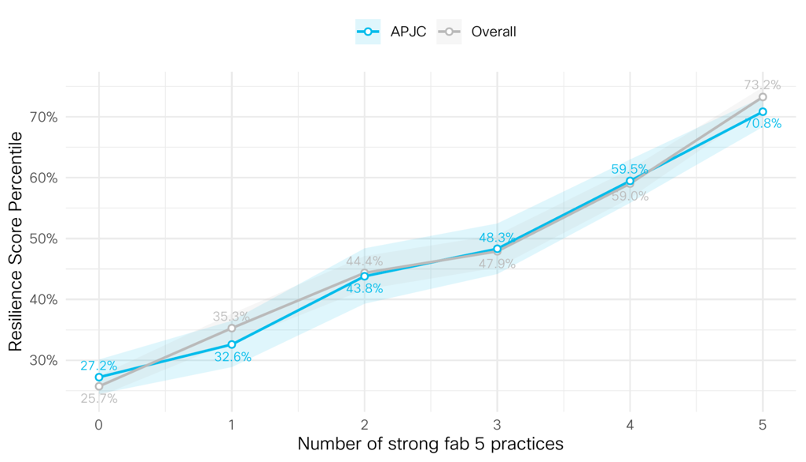As the world continues to face formidable challenges, one of the many things impacted is cybersecurity. While recent challenges have been varied, they have all contributed to great uncertainty. How can organizations stay strong and protect their environments amidst so much volatility?
Lately we’ve been talking a lot about security resilience, and how companies can embrace it to stay the course no matter what happens. By building a resilient security strategy, organizations can more effectively address unexpected disruptions and emerge stronger.
Through our Security Outcomes Study, Volume 2, we were able to benchmark how companies around the world are doing when it comes to cyber resilience. Recent blog posts have taken a look at security resilience in the EMEA and Americas regions, and this post assesses resilience in Asia Pacific, Japan and China (APJC).
While the Security Outcomes Study focuses on a dozen outcomes that contribute to overall security program success, for this analysis, we focused on four specific outcomes that are most critical for security resilience. These include: keeping up with the demands of the business, avoiding major cyber incidents, maintaining business continuity, and retaining talented personnel.
The following chart shows the proportion of organizations in each market within APJC that reported “excelling” in these four outcomes:

There is a lot of movement in this chart, but if you take a closer look, you will see that many of the percentage differences between markets are quite small. For example, 44.9% of organizations in the Philippines reported that they are proficient at keeping up with the business, with Mainland China closely following at 44.4%.
The biggest difference we see between the top spot and the bottom spot is around retaining security talent—42.4% of organizations in Australia reported that they were successful in that area, while only 18.3% of organizations in Hong Kong reported the same.
Next, we looked at the mean resilience score for each market in the region:

When we look at this, we can see the differences between the top six and bottom seven markets a bit more clearly. However, as the previous chart also showed, the differences are very slight. (When we take into account the gray error bars, they become even more slight.)
There are many factors that could contribute to these small differences when it comes to security resilience. But the most important thing to be gleaned from this data is how each market can improve its respective resilience level.
The Security Outcomes Study revealed the top five practices—what we refer to as “The Fab Five”—that make the most impact when it comes to enhancing security. The following chart outlines the Fab Five, and demonstrates how each market in the APJC region ranked its own strength across these practices.

If we look at Thailand, for example, 69.1% of organizations say they are adept at accurate threat detection, while only 28% of organizations in Taiwan say the same. Like in the previous charts, there is a lot of movement between how various markets reported their performance against these practices. However, it’s interesting to note that Taiwan remained consistent.
So does implementing the Fab Five improve resilience across organizations in APJC? Looking at the chart below, it’s safe to say that, yes, implementing the Fab Five does improve resilience. Organizations in APJC that did not implement any of the Fab Five practices ranked in the bottom 30% for resilience, whereas those that reported strength in all five rose to the top 30%.

While building resilience can sometimes seem like an elusive concept, we hope this data provides some concrete benchmarks to strive for in today’s security programs.
We’d love to hear what you think. Ask a Question, Comment Below, and Stay Connected with Cisco Secure on social!
Cisco Secure Social Channels
Instagram
Facebook
Twitter
LinkedIn
A deep dive into the latest updates from Secure Network and Cloud Analytics that show Cisco’s leadership in the Security Industry.

The year 2022 has been rather hectic for many reasons, and as the World undergoes its various challenges and opportunities, We At Cisco Security have buckled up and focused on improving the World in the way which we know best: by making it more Secure.
In an increasingly vulnerable Internet environment, where attackers rapidly develop new techniques to compromise organizations around the world, ensuring a robust security infrastructure becomes ever more imperative. Across the Cisco Security Portfolio, Secure Network Analytics (SNA) and Secure Cloud Analytics (SCA) have continued to add value for their customers since their inception by innovating their products and enhancing their capabilities.
In the latest SNA 7.4.1 release, four core features have been added to target important milestones in our roadmap. As a first addition, SNA has widely expanded on its Data Store deployment options by introducing the single node Data Store; supporting existing Flow Collector (FC) and new Data Store expansion by the Manager; and the capacity to mix and match virtual and physical appliances to build a Data Store deployment.
The SNA Data Store started as a simple concept, and while it maintained its simplicity, it became increasingly more robust and performant over the recent releases. In essence, it represents a new and improved database architecture design that can be made up of virtual or physical appliances to provide industry leading horizontal scaling for telemetry and event retention for over a year. Additionally, the Flow Ingest from the Flow Collectors is now separate from the data storage, which allows them to now scale to 500K + Flows Per Second (FPS). With this new database design, are now optimized for performance, which has improved across all metrics by a considerable amount.
For the second major addition, SNA now supports multi-telemetry collection within a single deployment. Such data encompasses network telemetry, firewall logging, and remote worker telemetry. Now, Firewall logs can be stored on premises with the Data Store, making data available to the Firepower Management Center (FMC) via APIs to support remote queries. From the FMC, users can pivot directly to the Data Store interface and look at detailed events that optimize SecOps workflows, such as automatically filtering on events of interest.
On the topic of interfaces, users can now benefit from an intelligent viewer which provides all Firewall data. This feature allows to select custom timeframes, apply unique filters on Security Events, create custom views based on relevant subsets of data, visualize trends from summary reports, and finally to export any such view as a CSV format for archiving or further forensic investigations.
With respect to VPN telemetry, the AnyConnect Secure Mobility Client can now store all network traffic even if users are not using their VPN in the given moment. Once a VPN connection is restored, the data is then sent to the Flow Collector, and, with a Data Store deployment, off-network flow updates can bypass FC flow caches which allow NVM historical data to be stored correctly.
Continuing down the Data Store journey (and, what a journey indeed), users can now monitor and evaluate its performance in a simple and intuitive way. This is achieved with charts and trends directly available in the Manager, which can now support traditional non-Data Store FCs and one singular Data Store. The division of Flow Collectors is made possible by SNA Domains, where a Data Store Domain can be created, and new FCs added to it when desired. This comes as part of a series of robust enhancements to the Flow Collector, where the FC can now be made up of a single image (NetFlow + sFlow) and its image can be switched between the two options. As yet another perk of the new database design, any FC can send its data to the Data Store.
As it can be seen, the Data Store has been the star of the latest SNA release, and for obvious good reasons. Before coming to an ending though, it has one more feature up its sleeve: Converged Analytics. This SNA feature brings a simplified, intuitive and clear analytics experience to Secure Network Analytics users. It comes with out- of-the-box detections mapped to MITRE with clearly defined tactics and techniques, self-taught baselining and graduated alerting, and the ability to quiet non-relevant alerts, leading to more relevant detections.
This new Analytics feature is a strong step forward to give users the confidence of network security awareness thanks to an intuitive workflow and 43 new alerts. It also gives them a deep understanding of each alert with observations and mappings related to the industry-standard MITRE tactics and techniques. When you think it couldn’t get any better, the Secure Network and Cloud Analytics teams have worked hard to add even more value to this release, and ensured the same workflows, functionality and user experience could be further available in the SCA portal. Yes, this is the first step towards a more cohesive experience across both SNA and SCA, where users of either platform will start to benefit from more consistent outcomes regardless of their deployment model. As some would say, it’s like a birthday coming early.

Pivoting to Secure Cloud Analytics, as per Network sibling, the product got several enhancements over the last months of development. The core additions revolve around additional detections and context, as well as usability and integration enhancements, including those in Secure Cloud Insights. In parallel with SNA’s Converged Analytics, SCA benefits from detections mapped to the MITRE ATT&CK framework. Additionally, several detections underwent algorithm improvements, while 4 new ones were added, such as Worm Propagation, which was native to SNA. Regarding the backbone of SCA’s alerts, a multitude of new roles and observations were added to the platform, to further optimize and tune the alerts for the users.
Additionally, alerts now offer a pivot directly to AWS’ load balancer and VPC, as well as direct access to Azure Security Groups, to allow for further investigation through streamlined workflows. The two Public Cloud Providers are now also included in coverage reports that provide a gap analysis to gain insight as to what logs may have potentially gone missing.
Focusing more on the detection workflows, the Alert Details view also got additional information pertaining to device context which gives insight into hostnames, subnets, and role metrics. The ingest mechanism has also gotten more robust thanks to data now coming from Talos intelligence feed and ISE, shown in the Event Viewer for expanded forensics and visibility use cases.
While dealing with integrations, the highly requested SecureX integration can now be enabled in 1 click, with no API keys needed and a workflow that is seamless across the two platforms. Among some of the other improvements around graphs and visualizations, the Encrypted Traffic widget now allows an hourly breakdown of the data, while the Event Viewer now displays bi-directional session traffic, to bring even greater context to SCA flows.
In the context of pivots, as a user is navigating through devices that, for example, have raised an alert, they will now also see the new functionality to pivot directly into the Secure Cloud Insights (SCI) Knowledge Graph, to learn more about how various sources are connected to one another. Another SCI integration is present within the Device Outline of an Alert, to gain more posture context, and as part of a configuration menu, it’s now possible to run cloud posture assessments on demand, for immediate results and recommendations.
With this all said, we from the Secure Analytics team are extremely excited about the adoption and usage of these features so that we can keep on improving the product and iterating to solve even more use cases. As we look ahead, the World has never needed more than now a comprehensive solution to solve one of the most pressing problems in our society: cyber threats in the continuously evolving Internet space. And Secure Analytics will be there, to pioneer and lead the effort for a safe World.
We’d love to hear what you think. Ask a Question, Comment Below, and Stay Connected with Cisco Secure on social!
Cisco Secure Social Channels